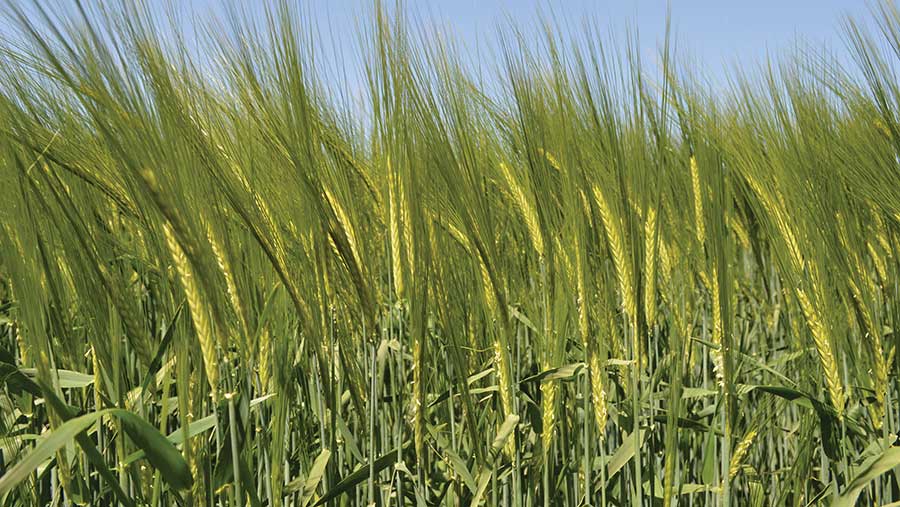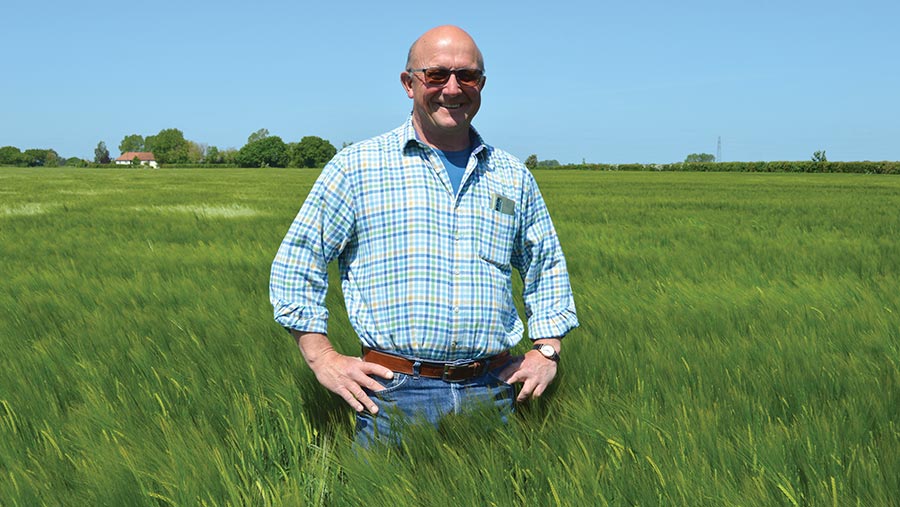New winter barley impresses on disease resistance and yields
 © MAG/David Jones
© MAG/David Jones Essex grower Andrew Fairley says his crop of the new winter barley Caravelle is the healthiest looking of the five varieties he growing this season, and it is set the replace his old favourite, Cassia, on his arable farm.
The new two-row feed variety entered the AHDB Recommended List late last year with a yield 2% above its nearest competitor, and matching the best of the six-row hybrids with a specific weight nearly equalling top-performer Cassia.
Andrew is impressed by its stiff straw, the multitude of ears the variety throws up and the absence of any disease even after a wet spring, and hopes it will make the top end of his medium-term yield range at 10t/ha.
See also: Big brewer offers a premium for regen barley
“Out of all the varieties I am growing, it looks the healthiest, and there is no sign of it going down. In fact, if it goes down, it will surprise me,” he tells Farmers Weekly.
Healthy variety
The variety is the healthiest he is growing, followed by Flynn and ahead of Bolton, Tardis and Cassia, and on straw height it is the shortest strawed along with Cassia, which Andrew sees as a big advantage on his farm, where yields average 9.25-10.0t/ha.
“It’s short strawed so there is less to process through the combine and less chance for it to fall over, and it is very clean of disease right down to the lower leaves,” he adds.
Andrew is growing 23ha of the variety for the first time this season on medium loam soils.
The 176ha Park Farm in Great Bromley, Essex, is one of driest spots in Britain, with an annual rainfall of 538mm.
He struggles to get good yields with winter wheats so he focuses on 131ha of winter barley with break crops of potatoes and combine peas for seed.
Four winter barley varieties are grown for seed – Caravelle, Bolton, Tardis and Cassia, with Flynn grown commercially because it gives a high specific weight from its big, long ears.
Cassia replacement
The Caravelle throws up a lot of smaller ears in comparison to Flynn, which Andrew says will mean it has less chance of lodging, and he expects the variety will replace Cassia on his farm due to the declining demand for seed of the older variety.
The current crop of Caravelle followed potatoes with the ground being sub-soiled and spring-tine cultivated before being drilled on 4 October at a seed rate of 195kg/ha.
The crop was treated with a pre-emergence herbicide and a pyrethroid insecticide to control aphids spreading barley yellow dwarf virus (BYDV).

© MAG/David Jones
“It was our first field drilled in the autumn as it was after irrigated potatoes, which means the ground will have had some moisture,” he says.
The crop had an application of polysulphate in the spring to provide sulphur and some potassium, and then 150kg/ha of solid ammonium nitrate in a 60:40 two-way split, with the first dose at the beginning of April and the second at the end of the same month.
Three-spray programme
He used a three-spray programme in the spring. The first on 16 April contained an SDHI-azole-strobilurin mix of fluxapyroxad, prothioconazole and pyraclostrobin to focus largely on rhynchosporium and net botch control, plus plant growth regulators (PGRs) chlormequat and Canopy (mepiquat chloride + prohexadione).
The second treatment on 30 April contained the multisite protectant fungicide folpet aimed primarily at ramularia control and also Canopy again.
His third treatment in the second half of May was a similar SDHI-azole-strobilurin mix to his first spray, but at a lower dose rate for late-season disease control.
Andrew’s agronomist, Marcus Mann from advisory group Frontier, was impressed with the new variety, which he said looked very good in the field.
“It looks a promising variety with similar high-yield qualities to Tardis and with a reasonable disease profile. It is stiff strawed but being a taller variety, it requires a reasonably robust plant growth regulator programme,” Marcus says.
Yield leap
Caravelle, from breeders Limagrain, made the AHDB Recommended List late last year showing a big leap in yield to 106%, ahead of the previous top two-rower Tardis, on 103%, and ahead of another newcomer Bolivia, on 104%, and equal to the top-yielding six-row hybrids.
It has done especially well in the eastern region, with a fungicide-treated yield of 109% – 4% ahead of the next two-rows and 3% ahead of the best six-row hybrids – and an overall untreated fungicide yield of 89%, equal with Bolivia and only just behind top two-rower Lightning on 90%, but well ahead of Tardis on 85%.
The variety shows a very high specific weight of 71.8kg/hl, only beaten by Cassia at 72.4kg/hl, and an early maturity similar to Tardis, Bolton, Orwell and Cassia – two key attributes for growers looking for good grain quality and an early entry for oilseed rape.

© MAG/David Jones
It shows good disease resistance to mildew (7) and rhynchosporium (6), while its resistance to lodging using a PGR is similar to Cassia at a 7 and a touch behind Tardis, Bolivia and Bolton on 8s, in a 1-9 scale where a high figure indicates that a variety shows the character to a high degree.
Limagrain says the variety has seen positive early demand in the marketplace and very strong support from the seed trade, and that there should be about 5,500-6,000t of C2 seed available for drilling this autumn.
At average seed rates and assuming an unchanged winter barley area next season, this could provide enough seed for about 8% of the UK area of winter barley next season.
Selection of winter barley varieties from the AHDB Recommended List |
|||||
|
Variety |
Caravelle |
Bolivia |
Tardis |
Bolton |
Cassia |
|
Fungicide-treated yield (% of control) |
106 |
104 |
103 |
103 |
97 |
|
East region (% of control) |
109 |
105 |
105 |
105 |
97 |
|
Untreated yield (% of control) |
89 |
89 |
85 |
86 |
82 |
|
Specific weight (kg/hl) |
71.8 |
70.2 |
70.6 |
69.9 |
72.4 |
|
Resistance to lodging without PGR |
– |
– |
8 |
7 |
7 |
|
Resistance to lodging with PGR |
7 |
8 |
8 |
8 |
7 |
|
Disease resistance |
|||||
|
Mildew |
7 |
7 |
5 |
6 |
5 |
|
Brown rust |
– |
– |
6 |
6 |
7 |
|
Rhynchosporium |
6 |
6 |
6 |
5 |
5 |
|
Net blotch |
5 |
6 |
5 |
5 |
5 |
|
Note: On the 1-9 scale, a high figure indicates a variety shows the character to a high degree |
|||||

